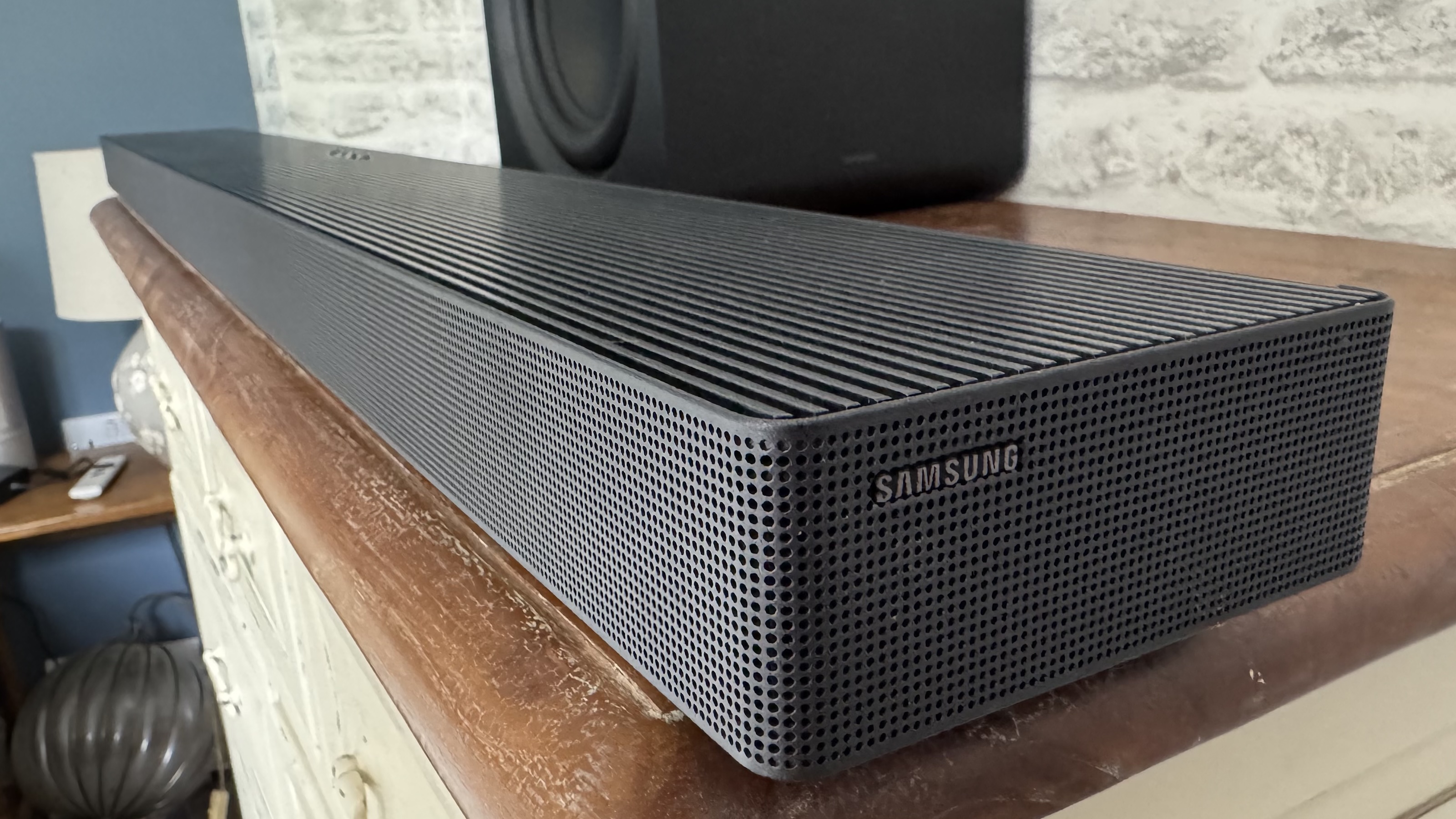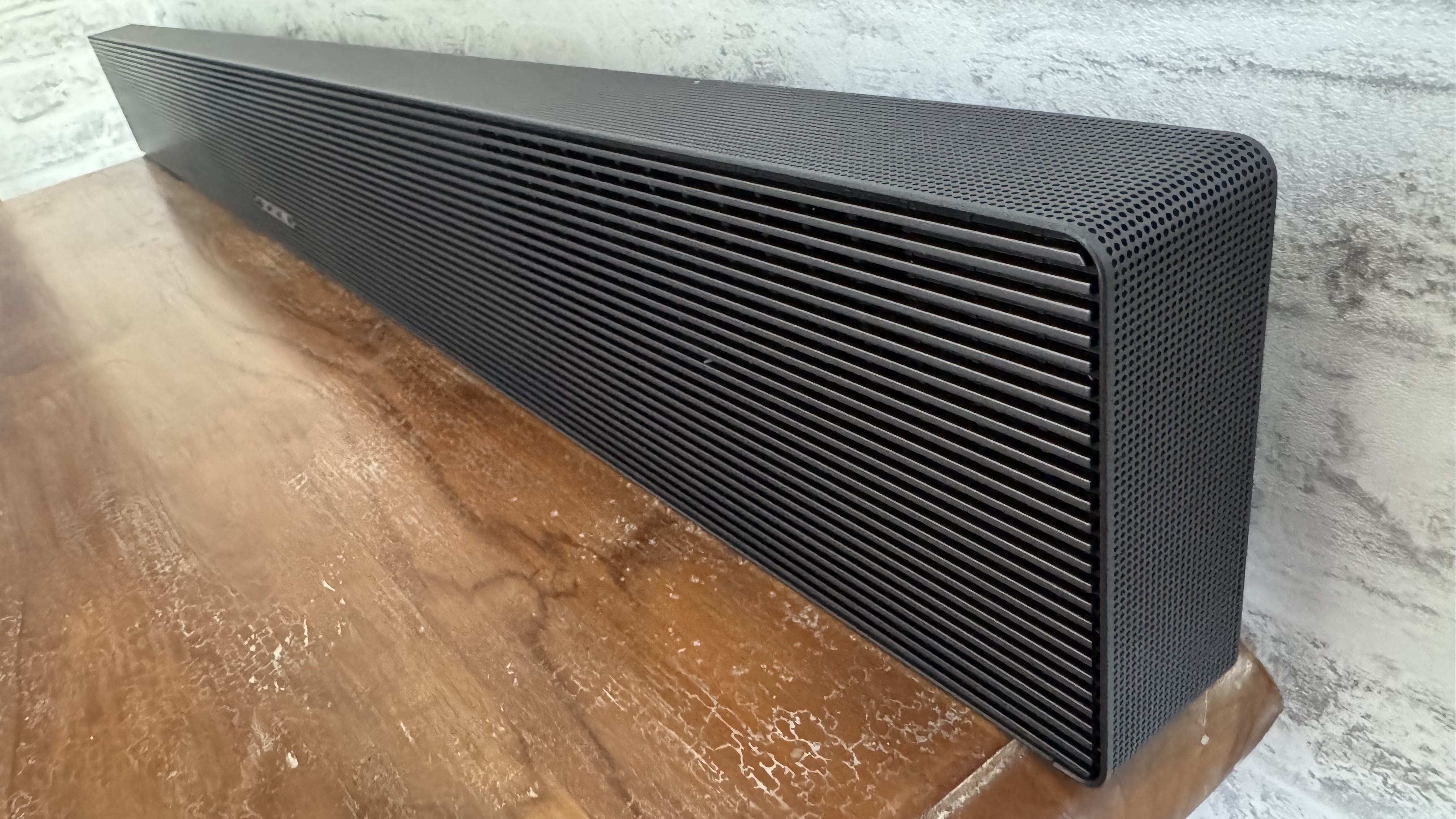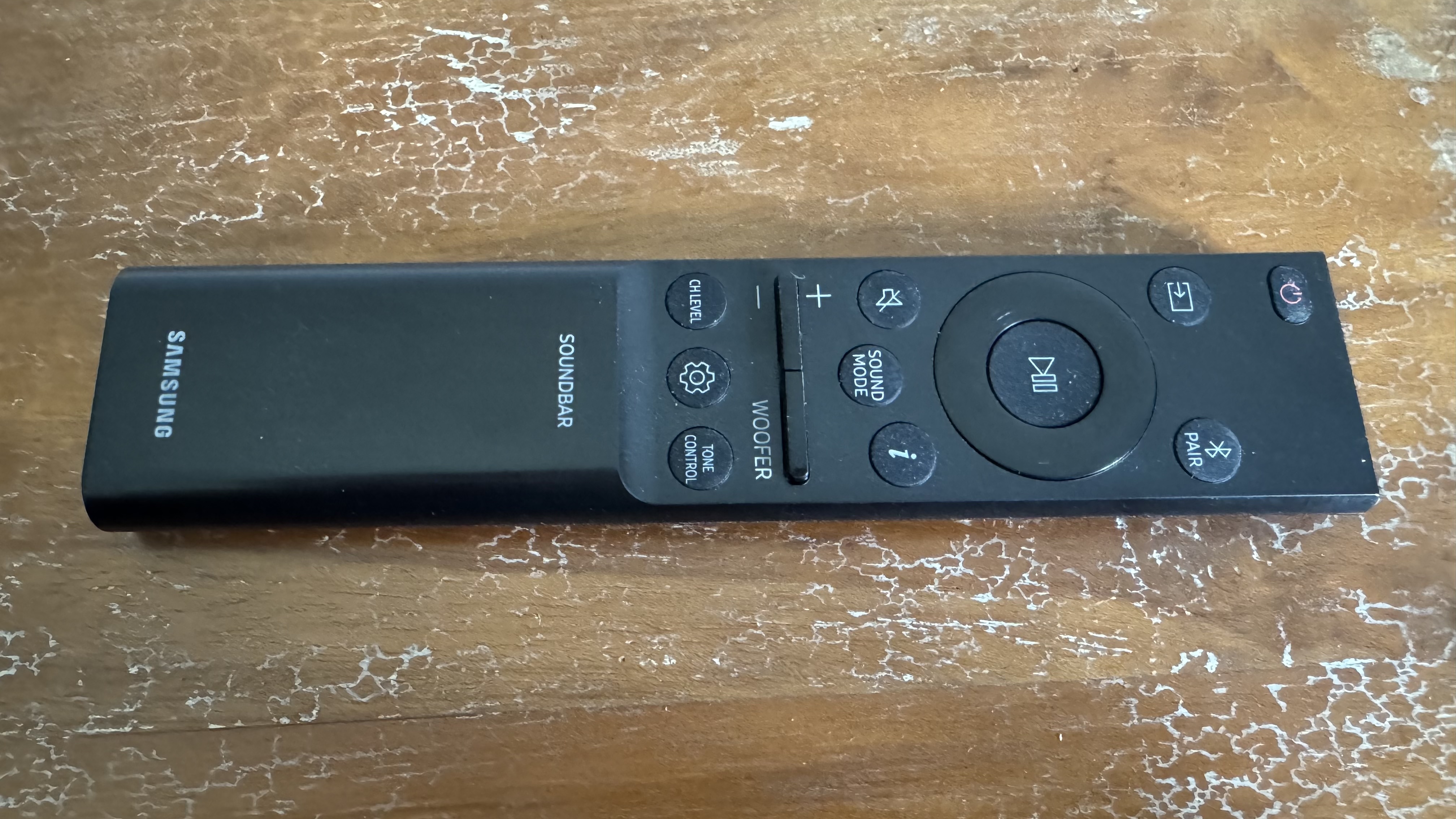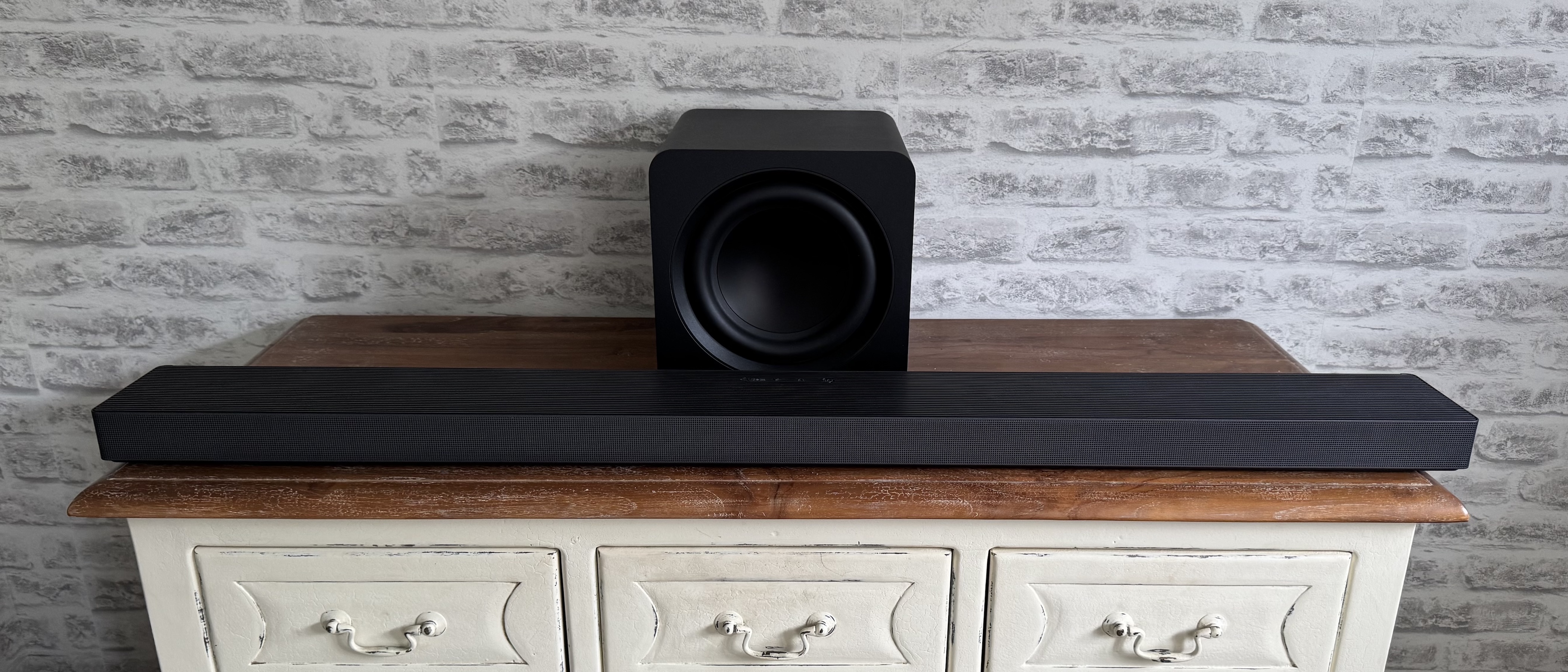TechRadar Verdict
The QS700F soundbar's fantastically flexible design, with its speakers taking on different roles depending on whether you’ve hung it on a wall or sat it on a table, hasn’t stopped it from delivering Samsung’s customary sound quality.
Pros
- +
Genuine multi-position design
- +
Sounds excellent in either of its configurations
- +
Soundbar and subwoofer harmonize well
Cons
- -
No surround channel sound effect
- -
Small sound differences between setup profiles
- -
No true LED display
Why you can trust TechRadar
Samsung HW-QS700F: Two-minute review
The Samsung HW-QS-700F is one of the company's latest soundbars. It combines the performance of Samsung’s Q series models with a stylish lifestyle-friendly design usually found in Samsung’s S series soundbars. Does this mean this crossover soundbar is twice as nice, though, or has becoming a jack of all trades made it a master of none?
At first glance, you might be forgiven for not understanding why the Samsung QS700F might be considered a designer ‘lifestyle’ example of the best soundbars. With its long, angular, hard-finished main soundbar and compact, roughly cubic subwoofer, it looks mighty similar to the components of Samsung’s latest performance-led Q series models.
That’s not to say it’s ugly; it’s slender enough to fit beneath most TV screens, long and deep enough to promise some potent sound, and robustly finished enough to feel like a premium product. And the new subwoofer design Samsung has adopted across most of its soundbar range this year might even be called cute thanks to its relatively small footprint, rounded edges, crisp black finish and jauntily large circular drivers.
In the end, though, despite unfortunately not joining most of Samsung’s performance-oriented Q series models in carrying a proper built-in LED display, it shares more immediate DNA with the Q series than the usually sleeker, smaller S Series.
The S part of the QS700F deal heaves into view with its so-called Convertible Fit feature. This “dynamic dual set-up” system means that, unlike the vast majority of other soundbars, the QS700F can be configured to truly work in either a wall hanging or stand placement.
Of course, many other soundbars out there can either be attached to a wall or placed on a bit of furniture. Practically none of those other soundbars, though, do what the QS700F does and actually adjust their speaker configuration to optimise their performance for their separate wall-hanging or stand placement options.
What happens with the QS700F, essentially, is that the front and up-firing height speakers in play when the soundbar is sat on a TV stand can reverse their functionality if you tip the soundbar up into a vertical position and turn it upside down to place it flat on a wall. There’s even a gyro system built into the QS700F’s main bar component that can automatically tell if the soundbar is being used flat or vertically, adjusting the sound channel configuration accordingly.
Sign up for breaking news, reviews, opinion, top tech deals, and more.
Pictures are worth a thousand words when it comes to explaining this extremely rare feature, so I suggest you take a moment to peruse the below images if you’re still struggling to figure out how it does what it does – and why the result is so different to simply sticking a regular soundbar on a wall bracket.


The QS700F isn’t the first soundbar that’s been expressly designed to look good and work well when mounted on a wall. Most wall-based soundbar designs, however, can’t also be used in a stand set-up. And soundbars that can do what the QS700F does and completely reconfigure their driver array to support both horizontal and vertical setups are very rare indeed. The main current model I can think of is the Devialet Dione, with its ‘rotating ball’ centre channel speaker, but that will currently set you back £1,800 / around $2,440 – two and a half times what the QS700F costs.
Delivering genuine wall or stand placement flexibility isn’t the QS700F’s only attraction, though. Its 3.1.2 channel count is also more numerous than might have been expected with such an affordable and customisable soundbar – especially given that the .2 bit indicates the presence of two up-firing speakers for Dolby Atmos height effects that are available in either of the soundbar’s two orientation options, and the .1 bass channel bit is delivered by an external subwoofer.
This subwoofer manages to combine likeable, compact aesthetics, too, with two startlingly large drivers on two of its opposing sides. One of these is an active 8-inch driver, while the other is a smaller, passive unit, with the dual-sided approach intended to make it possible to underpin music and, especially, film soundtracks with smoother and less directional bass than Samsung’s previous sub designs did.
The Dolby Atmos playback support (for music as well as movies) mentioned earlier is joined by support for DTS:X soundtracks too, while music lovers can enjoy their favourite tunes streamed in via direct Chromecast, Spotify Connect, Airplay and Tidal Connect support. Supported music file formats are expansive, too, including MP3, AAC, OGG, FLAC, WAV, ALAC and AIFF.
Stereo music can be played in its basic two-channel format by the QS700F, as you would expect, but its sound presets also include a couple of options that can upmix two-channel music to take advantage of all of the system’s available channels. The Surround mode is the most straightforward of these two options, while an Adaptive option brings AI into play, with a particular focus on optimising volume and enhancing detailing and clarity.
A Game preset, meanwhile, emphasises the multi-channel directionality of the surround sound (often Dolby Atmos) audio tracks modern games typically use, to both make the game world feel more immediate and intense, and to give you a better idea of exactly where approaching or attacking enemies are relative to your own position.

While the QS700F doesn’t carry nearly as many channels as you get with Samsung’s flagship soundbars for 2025, there’s still enough going on to potentially present you with a bit of a setup headache. Happily, though, Samsung has equipped the QS700F with a so-called SpaceFit Sound Pro system that automatically and constantly works to optimise the tone and impact of the bass to keep it in line with the rest of the soundstage, as well as keeping dialogue and effects in balance.
If you decide you want to make the QS700F a full surround system, you can either add a pair of Samsung’s SWA-9500S speakers for £249 / $299, or a pair of Samsung’s Music Frame speakers for a £800 / $600. As well as being much cheaper, I’d suggest the SWA-9500Ses would be the much better option for adding to the QS700F because they include extra up-firing speakers as well as the main forward-facing drivers, enhancing Dolby Atmos’s hemisphere of sound effect.
The QS700F is decently connected considering how affordable it is for such an innovative design, with an HDMI pass-through being joined by an optical digital audio input and the now expected Bluetooth and Wi-Fi streaming options. The Wi-Fi functionality even extends to support for Samsung’s Wireless Dolby Atmos streaming, where the soundbar can receive Dolby Atmos soundtracks from compatible Samsung TVs without the need for any cables.
The QS700F supports Samsung’s Q Symphony system, too, where the speakers in the TV can work alongside those in the soundbar to create a more detailed and well-staged soundscape, rather than the soundbar just taking over all sound duties by itself.
The one disappointment with the QS700F’s connections is that the HDMI pass-through doesn’t join the HDMI ports on Samsung’s Q990F flagship soundbar in supporting 4K 120Hz gaming feeds. So if you have a console or PC capable of outputting graphics to that format, you’ll have to connect your gaming device directly to your TV and use eARC functionality to send game sound from the TV to the soundbar. That approach can sometimes, though thankfully not that often these days, cause a loss of synchronisation between the pictures on your TV and the sound coming from the soundbar.

The QS700F’s performance turns out to be startlingly uncompromised by its innovative multi-placement design. There are some mild differences in how it sounds in its two usage configurations, but overall, it sounds excellent whichever way round you use it, and better, in fact, than most ‘standard’ soundbars at the same sort of price point.
Looking first at performance features that remain consistent regardless of whether you’re using the QS700F in its vertical or horizontal stance, the most immediate thing you notice is how powerful it is. Despite its fairly compact two-piece design, it’s capable of both getting seriously loud and projecting its sound far beyond the boundaries of its physical form. The result is a sound that’s capable of filling at least the front half of even quite a substantial room with a really potent soundstage.
There’s much more to the QS700F’s power and projection than just brute force and loudness, though. Its speakers are also sensitive enough to deliver impressive amounts of detail, be it a mild background ambient sound or a more specific, placed effect. Yet it does so with an excellent sense of balance, where no sound stands out artificially brightly from the mix.
Spot effects are accurately placed in the three-dimensional sound space the QS700F creates in either of its vertical or horizontal placement configurations, too, and sound transitions as noisy objects move around the three-dimensional space are tracked with strong and involving accuracy, clarity and consistency, even if there are multiple moving objects to track at the same time.
Impact sounds are delivered with a degree of venom and projection that’s rare indeed at the QS700F’s price point, while the subwoofer performs well beyond its size, underpinning action scenes with seriously deep and distortion-free rumbles. These also, crucially, feel like natural extensions of the dynamic range delivered by the main bar, with no sense of bagginess or dislocation in the way the subwoofer’s sound ‘attaches to’ it.
Treble effects, finally, also emerge without sounding distorted or overly shrill, especially as the subwoofer’s contributions at the other end of the spectrum provide such a potent counterpoint.
While the QS700F is at its absolute best as an ultra-flexible movie soundbar, it’s also a strong music performer. In either of its vertical or horizontal configurations, music enjoys good staging, with effective but not over-stated stereo separation, nicely positioned vocals that sit at the centre of and slightly above the rest of the mix, and some tight and typically well-timed and consistent bass from the subwoofer.
They might not be to everybody’s taste, but the surround sound upmixing options the QS700F provides for stereo sources work unusually well, too. There’s a level of intelligence and naturalism about the way elements in a stereo mix are separated out and redirected around the system’s 3.1.2 channels that you don’t get with arguably any other soundbar brand bar except, perhaps, Sony. Add a pair of the optional rear speakers and the upmixing becomes even more effective, sounding at times more like a professional surround mix than something that’s being essentially made up on the fly by Samsung’s processing.

Looking at the differences in the way the QS700F sounds in its vertical and horizontal configurations coincides for the most part with the weaker aspects of the soundbar’s performance.
Due I think to its rather unusual configuration, where it sits tucked up into the upper edge of the soundbar when it’s placed on a desktop so that it can also work when the soundbar has been turned upside down and placed vertically on a wall, the centre channel speaker isn’t a total success. It can sound a touch muffled at times when using the soundbar in its TV stand set up, and in the wall-hanging configuration, while dialogue sounds clearer, it can also sound like it’s coming from slightly below the onscreen action. (Simply overriding the auto-calibration system and turning the centre channel volume output up a couple of notches helps the stand set up centre channel issue, mind you.)
With the QS700F used vertically, for wall hanging, height and ambient effects in a Dolby Atmos mix aren’t spread quite as far and wide or with quite as much authority and polish as they are when the soundbar is in its desktop position. Finally, stereo music sounds slightly more open, rich and detailed with the QS700F in its vertical stance. In stand mode, stereo music sounds a bit hemmed in, not quite escaping from the soundbar’s bodywork as cleanly and effectively as movie soundtracks do.
In the end, I’d suggest sticking with Standard mode for stereo music playback if the soundbar’s hanging on a wall, but at least giving an extended trial to the Surround mode for two-channel music if the soundbar’s sat on a surface.
I need to wrap all this up, though, by circling back to the point I made earlier that while there are one or two mostly minor performance differences in how the QS700F sounds in its two different set ups, Samsung’s new soundbar’s unique convertible fit design doesn’t stop it from still sounding much better, especially with movies, in either of its configurations than the vast majority of normal soundbars do.
Samsung HW-QS700F review: Specs
Dimensions (W x H x D) | Main bar: 1160 x 51 x 120mm/45.67 x 2 x 4.725 in, Subwoofer: 249 x 252 x 249mm/9.8 x 9.92 x 9.8 in |
Speaker channels | 3.1.2 |
Connections: | HDMI input, HDMI output (eARC), Bluetooth 5.3, Wi-Fi, Airplay, digital optical input, wireless Dolby Atmos |
Dolby Atmos/DTS:X | Yes/Yes |
Sub included | Yes |
Rear speakers included | No |
Features | 4K 120Hz passthrough, voice assistant support, room calibration |
Samsung HW-QS700F review: Price & release date

- First available: April 2025
- Price: £749 / $699.99 / AU$999
The QS700F was released globally in April 2025. While the brand launched a slim-design Q700D soundbar in 2024, the QS700F’s unusual convertible fit design means that it stands as a new product category for Samsung rather than just being an evolution of a previous soundbar model.
The HW-QS700F costs £749 in the UK, $699.99 in the US and $999 in Australia. These prices make the QS700F great value for such a flexible but still high-performance model.
Should I buy the Samsung HW-QS700F?

Attributes | Notes | Rating |
Features | 3.1.2 channels of sound, Dolby Atmos and DTS support, Bluetooth, and a rare true multi-placement design | 4.5 / 5 |
Performance | Outstanding power, detail and staging that mostly holds up no matter which way round you use it | 4 / 5 |
Design | The way the speakers change their role to suit different setups is genius, and both the main bar and wireless sub are surprisingly compact for such a powerful system | 4 .5/ 5 |
Value | Considering the combination of performance and features it provides, the QS700F looks like a pretty good deal | 4.5 / 5 |
Buy it if...
You want a soundbar that can truly switch between wall and surface use
The QS700F joins the rare breed of soundbar design that can swap speaker duties around depending on whether the soundbar is hung on a wall or sat on a tabletop.
You want much more powerful sound than your TV could ever manage
Worries that the QS700F’s extremely unusual focus on delivering a low-profile design, whether it’s wall- or stand-mounted, would compromise Samsung’s usually powerful soundbar performance proved spectacularly unfounded. No TV sound system can sound anywhere near this good.
Don't buy it if...
You want an out-of-the-box full surround sound experience
While the QS700F creates a large soundstage, it doesn’t include any rear speakers and so can’t extend its sound behind you.
You’re sure you will only ever want to sit your soundbar on a piece of furniture
If you don’t envisage ever wall-hanging your soundbar, then I guess you could get a ‘normal’ soundbar instead. Though the QS700F sounds good enough in its simple desktop mode to stand tall against most of its ‘standard’ mid-range rivals.
Samsung HS-QS700F soundbar: Also consider
| Row 0 - Cell 0 | Samsung HW-QS700F | Sonos Arc Ultra | Samsung HW-Q800D |
Price: | £749/$699/AU$999 | £999/$999/AU$1,799 | £699/$699/AU$799 |
Dimensions (w x h x d): | Main bar: 1160 x 51 x 120mm/45.67 x 2 x 4.725 inches, Subwoofer: 249 x 252 x 249mm/9.8 x 9.92 x 9.8 inches | 1178 x 75 x 110.6mm/46.38 x 2.95 x 4.35 inches | Main bar - 1110.7 x 60.4 x 120mm/43.73 x 2.38 x 4.73 inches; Subwoofer - 403 x 210 x 403mm/15.87 x 8.27 x 15.87 |
Speaker Channels: | 3.1.2 | 9.1.4 | 5.1.2 |
Connections: | HDMI input, HDMI output (eARC), Bluetooth 5.3, Wi-Fi, Airplay, digital optical input, wireless Dolby Atmos | HDMI input (eARC), Bluetooth, Ethernet port, Wi-Fi, Airplay, Sonos Multiroom | HDMI input, HDMI output (with eARC), Bluetooth 5.2, Wi-Fi, digital optical audio, Airplay, Wireless Dolby Atmos |
Dolby Atmos/DTS:X: | Yes/Yes | Yes/No | Yes/Yes |
Sub / rear speakers included: | Yes/No | No/No | Yes/No |
Sonos Arc Ultra
The Sonos Arc Ultra is one of our current favourite one-box soundbars. The scale and detail of the sound it’s able to produce from its surprisingly compact form is incredible, and while it doesn’t ship with a subwoofer, its integrated low frequency system still delivers startling amounts of rumble and bass. You can add optional rear and subwoofer speakers too. The Sonos Arc Ultra doesn’t support true multi-position placement like the QS700F, though, and it also costs £250 more.
Read our full Sonos Arc Ultra review
Samsung HW-Q800D
The Samsung HW-Q800D was rated by us in our recent best soundbars of 2025 selection as the best soundbar for most people. A position it earns by virtue of being an excellent all-rounder that combines outstanding sound quality, a compact two-piece design, good connectivity and a great value price considering what it offers. It’s a 2024 model, though, so if you want one, you’d best be quick about it – and again, it doesn’t truly support multi-position placement like the QS700F does.
Read our full Samsung HW-Q800D review
How I tested the Samsung HW-QS700F

- Tested across 9 days
- Used in both a regular living room environment and a dedicated test room, in both its wall-mount and stand mount orientations
- Tested with a mixture of music and video sources
Testing the Samsung QS700F was more complicated than usual, thanks to its Convertible Fit technology, requiring it to be used for half the time in a regular surface-mounted stance, and half the time in a vertical wall-mounted stance. I tested it extensively in both of its configurations with a range of CDs, high-quality audio streams and 4K Blu-ray movie soundtracks.
The 4K Blu-ray soundtracks I used included both Dolby Atmos and DTS:X mixes, since the QS700F supports both, while stereo music was tested both in native two-channel mode and using the soundbar’s multi-channel upmix feature.
First reviewed: June 2025

John has been writing about home entertainment technology for more than two decades - an especially impressive feat considering he still claims to only be 35 years old (yeah, right). In that time he’s reviewed hundreds if not thousands of TVs, projectors and speakers, and spent frankly far too long sitting by himself in a dark room.
You must confirm your public display name before commenting
Please logout and then login again, you will then be prompted to enter your display name.
